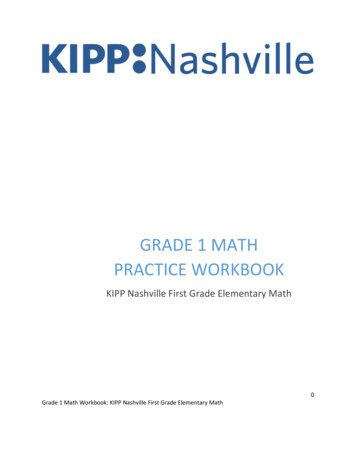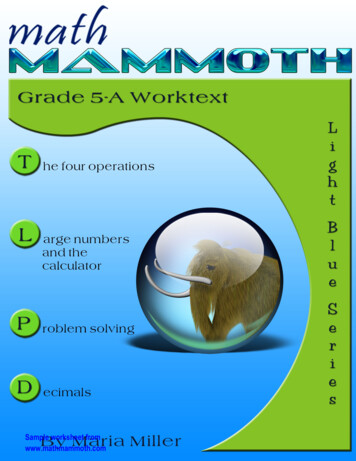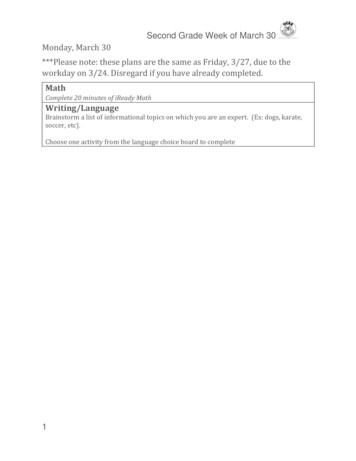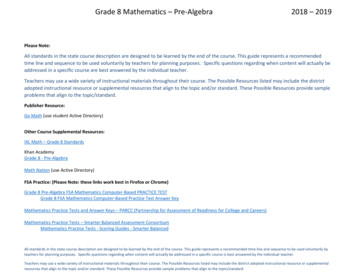
Transcription
GRADE 1 MATHPRACTICE WORKBOOKKIPP Nashville First Grade Elementary Math0Grade 1 Math Workbook: KIPP Nashville First Grade Elementary Math
Practice WorkbooksElementary Math – Grade 1ContentsPractice Workbook A . 31.NBT.A.1 – Count to 120, starting at any number less than 120. In this range, read and writenumerals and represent a number of objects with a written numeral. . 3Practice Workbook C. 61.OA.C.7 – Understand the meaning of the equal sign, and determine if equations involving additionand subtraction are true or false. . 61.OA.C.8 – Determine the unknown whole number in an addition or subtraction equation relatingthree whole numbers. 81.NBT.B.2 – Understand that the two digits of a two-digit number represent amounts of tens andones. Understand the following as special cases: a) 10 can be thought of as a bundle of ten ones –called a “ten.” b) the numbers from 11 to 19 are composed of a ten and one, two, three, four, five, six,seven, eight, or nine ones. c) The numbers 10, 20, 30, 40, 50, 60, 70, 80, 90 refer to one, two, three,four, five, six, seven, either, or nine tens (and 0 ones). 111.NBT.B.3 – Compare two two-digit numbers based on meanings of the tens and ones digits,recording the results of comparisons with the symbols , , and . . 141.NBT.C.5 – Given a two-digit number, mentally find 10 more or 10 less than the number, withouthaving to count; explain the reasoning being used. . 171.NBT.C.6 – Subtract multiples of ten in the range 10-90 from multiples of 10 in the range 10-90(positive or zero differences), using concrete models or drawings and strategies based on place value,properties of operations, and/or the relationship between addition and subtraction; relate thestrategy to a written method and explain the reasoning used. . 19Practice Workbook E . 211.MD.C.4 – Organize, represent, and interpret data with up to three categories; ask and answerquestions about the total number of data points, how many in each category, and how many more orless in one category than in another. . 211.MD.A.1 – Order three objects by length; compare the lengths of two objects indirectly by using athird object. 261Grade 1 Math Workbook: KIPP Nashville First Grade Elementary Math
1.MD.A.2 – Express the length of an object as whole number of length units, by laying multiplecopies of a shorter object end to end; understand that then length measurement of an object is theumber of same-size length units that span it with no gaps or overlaps. . 271.MD.B.3 – Tell and write time in hours and half-hours using analog and digital clocks. . 311.G.A.3 – Partition circles and rectangles into two and four equal shares, describe the shares usingthe words halves, fourths, and quarters, and use the phrases half of, fourth of, and quarter of.Describe the whole as two of, or four of the shares. Understand for these examples thatdecomposing into more equal shares creates smaller shares. . 36Practice Workbook F . 381.NBT.C.4 – Add within 100, including adding a two-digit number and a one-digit number, andadding a two-digit number and a multiple of 10, using concrete models, or drawings and strategiesbased on place value, properties of operations, and/or the relationship between addition andsubtraction; relate the strategy to a written method and explain the reasoning used. Understand thatin adding two-digit numbers, one adds tens and tens, ones and ones; and sometimes it is necessary tocompose a ten. 382Grade 1 Math Workbook: KIPP Nashville First Grade Elementary Math
Practice Workbook A1.NBT.A.1 – Count to 120, starting at any number less than 120. In this range, read andwrite numerals and represent a number of objects with a written numeral.Directions: Fill in the number that comes next in each sequence.85, 86, 87, 88, 89,39, 40, 41, 42, 43,95, 96, 97, 98, 99,101, 102, 103, 104, 105,105, 106, 107, 108, 109,Directions: Fill in the rest of the chart.5152535455563132333435365758593Grade 1 Math Workbook: KIPP Nashville First Grade Elementary Math
9192939495969771727374757677984Grade 1 Math Workbook: KIPP Nashville First Grade Elementary Math
Directions: Fill in the rest of the chart.2122232425262728295Grade 1 Math Workbook: KIPP Nashville First Grade Elementary Math
Practice Workbook C1.OA.C.7 – Understand the meaning of the equal sign, and determine if equationsinvolving addition and subtraction are true or false.Directions: Circle TRUE or FALSE to tell about the equation.Equations7 6 142 2 2 610 – 5 510 – 7 44 4 75 4 98-3 614 – 6 96 5 118 10 1920 – 7 1519 – 4 13True OR alseTrueFalseDirections: Circle TRUE or FALSE to tell about the equation.Equations4 1 2 32 5 4 36 4 4 62 7 8 39 1 6 35 1 6 08 1 3 66 2 4 312 3 5 95 6 7 4True OR TrueFalseTrueFalseTrueFalseTrueFalseTrueFalse
Directions: Circle TRUE or FALSE to tell about the equation.Equations14 – 6 12 – 410 – 5 5 – 07–3 8–212 – 6 14 – 616 – 6 17 – 78 – 3 12 – 617 – 9 19 – 116–2 8–413 – 6 14 – 719 – 5 17 – 3True OR tions: Make Each Equation TRUE by writing the missing addend.4 6 85 4 4 3 4 10 7 6 9 1 4 8 0 92 3 2 7 8 26 3 45 4 3Grade 1 Math Workbook: KIPP Nashville First Grade Elementary Math7
1.OA.C.8 – Determine the unknown whole number in an addition or subtraction equationrelating three whole numbers.Directions: Write a related addition and subtraction number sentence for eachnumber bond.71036936532Grade 1 Math Workbook: KIPP Nashville First Grade Elementary Math8
461085733143Grade 1 Math Workbook: KIPP Nashville First Grade Elementary Math3639
2932471298133Grade 1 Math Workbook: KIPP Nashville First Grade Elementary Math310
Practice Workbook D1.NBT.B.2 – Understand that the two digits of a two-digit number represent amounts oftens and ones. Understand the following as special cases: a) 10 can be thought of as abundle of ten ones – called a “ten.” b) the numbers from 11 to 19 are composed of a tenand one, two, three, four, five, six, seven, eight, or nine ones. c) The numbers 10, 20, 30,40, 50, 60, 70, 80, 90 refer to one, two, three, four, five, six, seven, either, or nine tens(and 0 ones)Directions: Answer each question.1. What does the 2 mean in thenumber 28?28A.B.C.D.122002023. How many tens are in 58?A.B.C.D.5085805. Which number is represented?2. Which number has 6 tens?A.B.C.D.469662594. Which number has 7 ones and 4tens?A.B.C.D.74704474076. Show the number 57 in tens andones?Grade 1 Math Workbook: KIPP Nashville First Grade Elementary Math11
7. What does the 7 mean in the number 67? 8. Which number has 4 tens?67A.B.C.D.677707009. How many tens are in 37?A.B.C.D.373070A.B.C.D.10. Which number has 6 ones and8 tens?A.B.C.D.11.Which number is represented?46945256688068660812.Show the number 39 in tensand ones.Grade 1 Math Workbook: KIPP Nashville First Grade Elementary Math12
13. What does the 8 mean in thenumber 89?8915. How many tens are in 97?A.B.C.D.97907017.Which number is represented?14. Which number has 7 ones?A.B.C.D.7656577516. Which number has 5 tens and 4ones?A.B.C.D.455450440518.Show the number 83 in tens andones.Grade 1 Math Workbook: KIPP Nashville First Grade Elementary Math13
1.NBT.B.3 – Compare two two-digit numbers based on meanings of the tens and onesdigits, recording the results of comparisons with the symbols , , and .Directions: Answer each question.1. Which number is more than 52 butless than 63?a.b.c.d.655949703. Fill in the blanks with the correctsymbol.2. Which number belongs in theblank? 75A. 72B. 78C. 67D. 754. Which number would make thisstatement true?43 34 5692 57A.B.C.D.92 956572495827 615. Circle all of the numbers that would 6. Which number belongs in themake this statement true:blank? 71A.B.C.D.58718649 78A.B.C.D.72786775Grade 1 Math Workbook: KIPP Nashville First Grade Elementary Math14
7. Which number is more than 37, butless than 47?a.b.c.d.655949409. Fill in the blanks with the correctsymbol.8. Which number belongs in theblank? 89A.B.C.D.7288679010.Which number would make thisstatement true?58 85 3337 47A.B.C.D.23 176527495866 6611.Circle all of the numbers that would 12.Which number belongs in themake this statement true:blank? 56A.B.C.D.55718649 33A.B.C.D.72783375Grade 1 Math Workbook: KIPP Nashville First Grade Elementary Math15
13.Which number is more than 85 butless than 98?a.b.c.d.9399498415.Fill in the blanks with the correctsymbol.14.Which number belongs in theblank? 29A.B.C.D.322817916.Which number would make thisstatement true?36 25 3390 80A.B.C.D.24 376527495867 6617.Circle all of the numbers that would 18.Which number belongs in themake this statement true:blank? 56A.B.C.D.55718649 33A.B.C.D.72783375Grade 1 Math Workbook: KIPP Nashville First Grade Elementary Math16
1.NBT.C.5 – Given a two-digit number, mentally find 10 more or 10 less than the number,without having to count; explain the reasoning being used.Directions: Write the number that is 10 more than the given number.57 1034 1021896348729080 1056 10417729623579Directions: Write the amount that is 10 less than the given number.57 -1034 -1021896348729080 -1056 -10417729623593Grade 1 Math Workbook: KIPP Nashville First Grade Elementary Math17
Directions: Write the amount that is 10 more than the given number.15 1023 1076314966819011 1073 10485235847719Directions: Write the amount that is 10 less than the given number15 -1023 -1076314966819011 -1073 -10485235847719Grade 1 Math Workbook: KIPP Nashville First Grade Elementary Math18
1.NBT.C.6 – Subtract multiples of ten in the range 10-90 from multiples of 10 in the range10-90 (positive or zero differences), using concrete models or drawings and strategiesbased on place value, properties of operations, and/or the relationship between additionand subtraction; relate the strategy to a written method and explain the reasoning used.Directions: Subtract.Equation80 – 60 70 – 30 90 – 50 40 – 20 60 – 50 50 – 30 30 – 10 20 – 20 80 – 50 70 – 20 90 – 40 40 – 10 60 – 40 50 – 20 30 – 20 20 – 10 80 – 80 70 – 50 90 – 70 40 – 40 60 – 10 50 – 40 30 – 30 AnswerGrade 1 Math Workbook: KIPP Nashville First Grade Elementary Math19
Directions: Subtract.Equation80 – 30 70 – 10 90 – 20 40 – 10 60 – 20 50 – 40 30 – 20 20 – 0 80 – 20 70 – 10 90 – 20 40 – 30 60 – 20 50 – 40 30 – 30 20 – 20 80 – 30 70 – 20 90 – 40 40 – 10 60 – 20 50 – 10 30 – 20 AnswerGrade 1 Math Workbook: KIPP Nashville First Grade Elementary Math20
Practice Workbook E1.MD.C.4 – Organize, represent, and interpret data with up to three categories; ask andanswer questions about the total number of data points, how many in each category, andhow many more or less in one category than in another.iGrade 1 Math Workbook: KIPP Nashville First Grade Elementary Math21
iiGrade 1 Math Workbook: KIPP Nashville First Grade Elementary Math22
8.9.iiiGrade 1 Math Workbook: KIPP Nashville First Grade Elementary Math23
10.11.12.ivGrade 1 Math Workbook: KIPP Nashville First Grade Elementary Math24
13.14.15.16.vGrade 1 Math Workbook: KIPP Nashville First Grade Elementary Math25
1.MD.A.1 – Order three objects by length; compare the lengths of two objects indirectlyby using a third object.Grade 1 Math Workbook: KIPP Nashville First Grade Elementary Math26
1.MD.A.2 – Express the length of an object as whole number of length units, by layingmultiple copies of a shorter object end to end; understand that then lengthmeasurement of an object is the umber of same-size length units that span it with nogaps or overlaps.2. Use centimeter cubes to measure the length of this marker. Howmany centimeters cubes long is the marker?3. Marta is trying to measure this piece of string. Help her find thelength of the string, in centimeter cubes.cm cubesGrade 1 Math Workbook: KIPP Nashville First Grade Elementary Math27
Directions: Use ruler to measure each object in inches. Record your measurements.ObjectGrade 1 Math Workbook: KIPP Nashville First Grade Elementary MathLength (inch tiles)28
Directions: Circle Yes or No to tell if each measure tells the length of the line.a.6 centimetersYesNob.3 centimetersYesNoc.4 centimetersYesNod.5 centimetersYesNoDirections: Use an inch tiles to measure each snake to the nearest inch.Directions: For numbers 7-10, measure with inch tiles.1. How long is the board?Grade 1 Math Workbook: KIPP Nashville First Grade Elementary Math29
2. How long is the crayon?3. How long is the eraser?4. How long is the snake?Grade 1 Math Workbook: KIPP Nashville First Grade Elementary Math30
1.MD.B.3 – Tell and write time in hours and half-hours using analog and digital clocks.1. What time is shown on the clock?::::::::viGrade 1 Math Workbook: KIPP Nashville First Grade Elementary Math31
2. What time is shown on the clock?::::::::viiGrade 1 Math Workbook: KIPP Nashville First Grade Elementary Math32
Directions: Circle the clock that matches the time shown.Directions: Circle the clock that matches the time shown.Grade 1 Math Workbook: KIPP Nashville First Grade Elementary Math33
Directions: Circle the clock that matches the time shown.Directions: Circle the clock that matches the time shown.viiiGrade 1 Math Workbook: KIPP Nashville First Grade Elementary Math34
Directions: Draw hands on the clock to show the time.9:304 o’clock6 o’clockHalf past 3Half past 212:3010:0012:00ixGrade 1 Math Workbook: KIPP Nashville First Grade Elementary Math35
1.G.A.3 – Partition circles and rectangles into two and four equal shares, describe theshares using the words halves, fourths, and quarters, and use the phrases half of, fourthof, and quarter of. Describe the whole as two of, or four of the shares. Understand forthese examples that decomposing into more equal shares creates smaller shares.Directions: X all of the shapes that show ½ colored in.xDirections: Show different ways to divide the rectangle into halves.Grade 1 Math Workbook: KIPP Nashville First Grade Elementary Math36
Directions: Show different ways to divide the square into fourths.Directions: X all of the shapes that show ¼ colored in.xiDirections: Show different ways to divide the rectangle into quarters.Grade 1 Math Workbook: KIPP Nashville First Grade Elementary Math37
Directions: Color one half of the square and one quarter of the circle.Practice Workbook F1.NBT.C.4 – Add within 100, including adding a two-digit number and a one-digit number,and adding a two-digit number and a multiple of 10, using concrete models, or drawingsand strategies based on place value, properties of operations, and/or the relationshipbetween addition and subtraction; relate the strategy to a written method and explainthe reasoning used. Understand that in adding two-digit numbers, one adds tens andtens, ones and ones; and sometimes it is necessary to compose a ten.Directions: Add.72 7 48 7 43 3 88 6 58 2 73 9 62 4 55 8 83 5 66 5 Grade 1 Math Workbook: KIPP Nashville First Grade Elementary Math38
93 6 37 9 Directions: Add.72 10 40 11 40 23 88 10 58 20 73 20 60 34 55 30 83 10 60 23 70 16 30 51 Grade 1 Math Workbook: KIPP Nashville First Grade Elementary Math39
Directions: Add.72 9 48 10 43 20 88 7 50 24 6 28 52 9 50 37 73 18 66 25 3 29 3 55 iEngageNY First Grade by EngageNY licensed under Creative Commons Attribution International 4.0 (CCBY-NC-SA.) Achievement First does not own the copyright in “Fluency Workbook” and claims noGrade 1 Math Workbook: KIPP Nashville First Grade Elementary Math40
copyright in this material. The material is being used exclusively for non-profit educational purposesunder fair use principles in U.S. Copyright laws. The user should make the judgment about whether thismaterial may be used under fair use / fair dealing permissions in the user’s country.iiEngageNY First Grade by EngageNY licensed under Creative Commons Attribution International4.0 (CC BY-NC-SA.) Achievement First does not own the copyright in “Fluency Workbook” and claims nocopyright in this material. The material is being used exclusively for non-profit educational purposesunder fair use principles in U.S. Copyright laws. The user should make the judgment about whether thismaterial may be used under fair use / fair dealing permissions in the user’s country.iiiEngageNY First Grade by EngageNY licensed under Creative Commons Attribution International4.0 (CC BY-NC-SA.) Achievement First does not own the copyright in “Fluency Workbook” and claims nocopyright in this material. The material is being used exclusively for non-profit educational purposesunder fair use principles in U.S. Copyright laws. The user should make the judgment about whether thismaterial may be used under fair use / fair dealing permissions in the user’s country.ivEngageNY First Grade by EngageNY licensed under Creative Commons Attribution International4.0 (CC BY-NC-SA.) Achievement First does not own the copyright in “Fluency Workbook” and claims nocopyright in this material. The material is being used exclusively for non-profit educational purposesunder fair use principles in U.S. Copyright laws. The user should make the judgment about whether thismaterial may be used under fair use / fair dealing permissions in the user’s country.vEngageNY First Grade by EngageNY licensed under Creative Commons Attribution International4.0 (CC BY-NC-SA.) Achievement First does not own the copyright in “Fluency Workbook” and claims nocopyright in this material. The material is being used exclusively for non-profit educational purposesunder fair use principles in U.S. Copyright laws. The user should make the judgment about whether thismaterial may be used under fair use / fair dealing permissions in the user’s country.vi“ETC” by Florida Center for Instructional Technology. Achievement First does not own the copyright in“Fluency Workbook” and claims no copyright in this material. The material is being used exclusively fornon-profit educational purposes under fair use principles in U.S. Copyright laws. The user should makethe judgment about whether this material may be used under fair use / fair dealing permissions in theuser’s country.vii“ETC” by Florida Center for Instructional Technology. Achievement First does not own the copyright in“Fluency Workbook” and claims no copyright in this material. The material is being used exclusively fornon-profit educational purposes under fair use principles in U.S. Copyright laws. The user should makethe judgment about whether this material may be used under fair use / fair dealing permissions in theuser’s country.viii“ETC” by Florida Center for Instructional Technology. Achievement First does not own the copyright in“Fluency Workbook” and claims no copyright in this material. The material is being used exclusively fornon-profit educational purposes under fair use principles in U.S. Copyright laws. The user should makethe judgment about whether this material may be used under fair use / fair dealing permissions in theuser’s country.ix“ETC” by Florida Center for Instructional Technology. Achievement First does not own the copyright in“Fluency Workbook” and claims no copyright in this material. The material is being used exclusively fornon-profit educational purposes under fair use principles in U.S. Copyright laws. The user should makethe judgment about whether this material may be used under fair use / fair dealing permissions in theuser’s country.Grade 1 Math Workbook: KIPP Nashville First Grade Elementary Math41
x“ETC” by Florida Center for Instructional Technology. Achievement First does not own the copyright in “FluencyWorkbook” and claims no copyright in this material. The material is being used exclusively for non-profiteducational purposes under fair use principles in U.S. Copyright laws. The user should make the judgment aboutwhether this material may be used under fair use / fair dealing permissions in the user’s country.xi“ETC” by Florida Center for Instructional Technology. Achievement First does not own the copyright in “FluencyWorkbook” and claims no copyright in this material. The material is being used exclusively for non-profiteducational purposes under fair use principles in U.S. Copyright laws. The user should make the judgment aboutwhether this material may be used under fair use / fair dealing permissions in the user’s country.Grade 1 Math Workbook: KIPP Nashville First Grade Elementary Math42
Grade 1 Math Workbook: KIPP Nashville First Grade Elementary Math 1.MD.A.2 – Express the length of an object as whole number of length units, by laying multiple copies of a shorter object end to end; un










